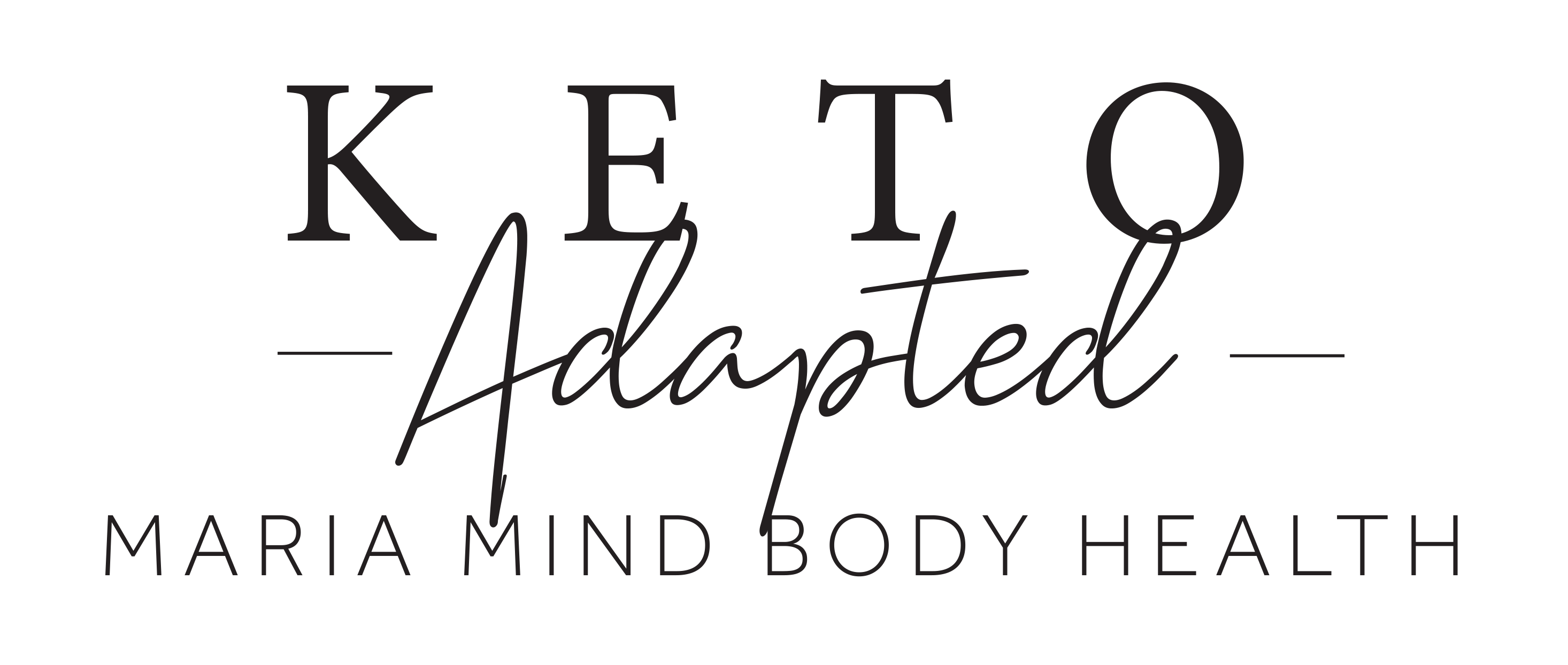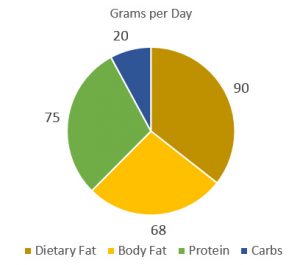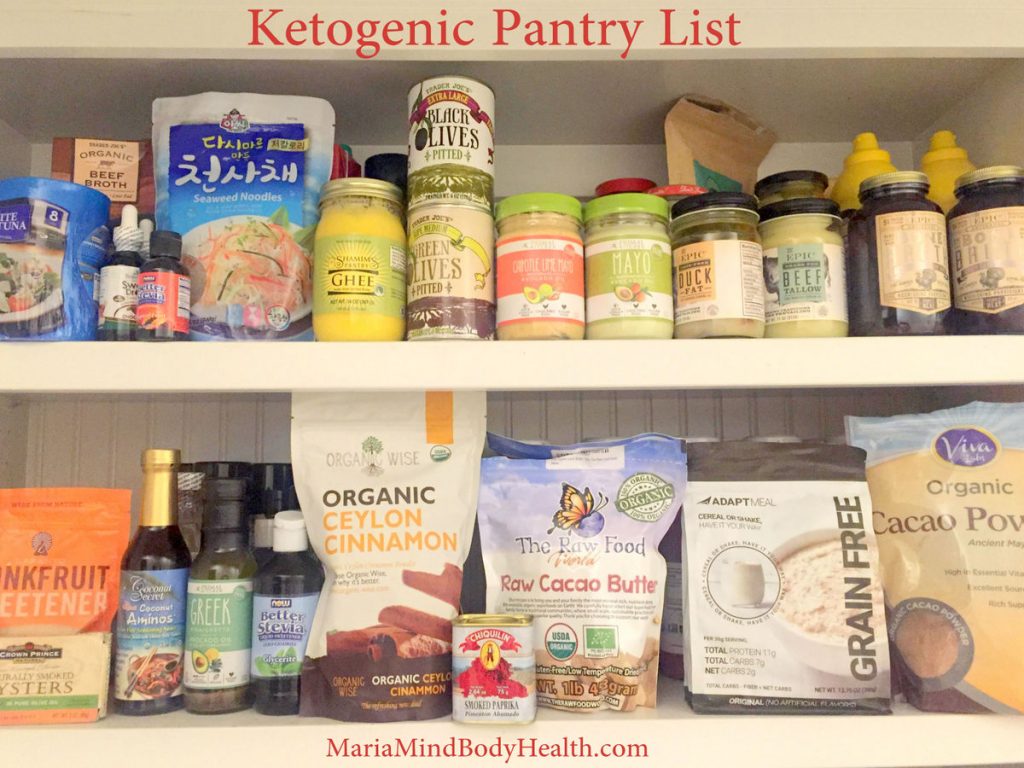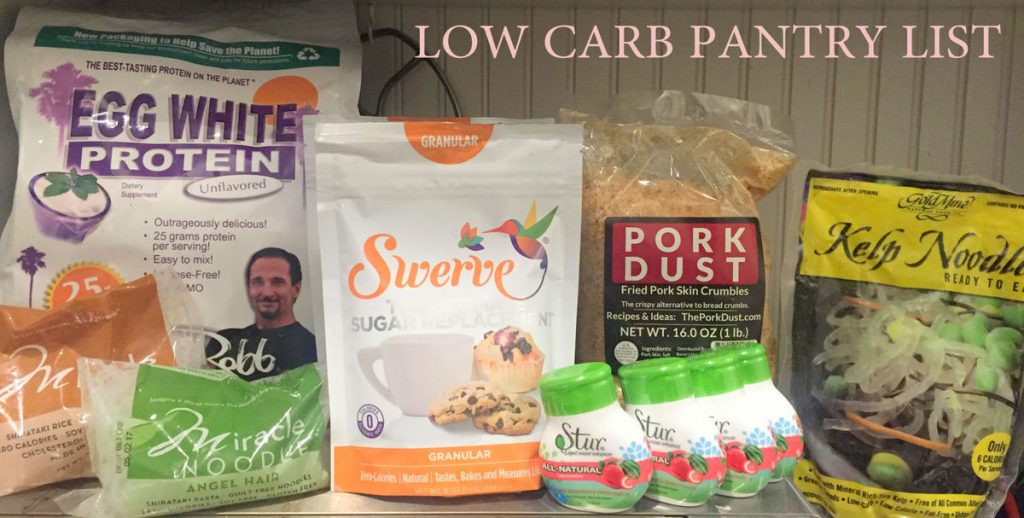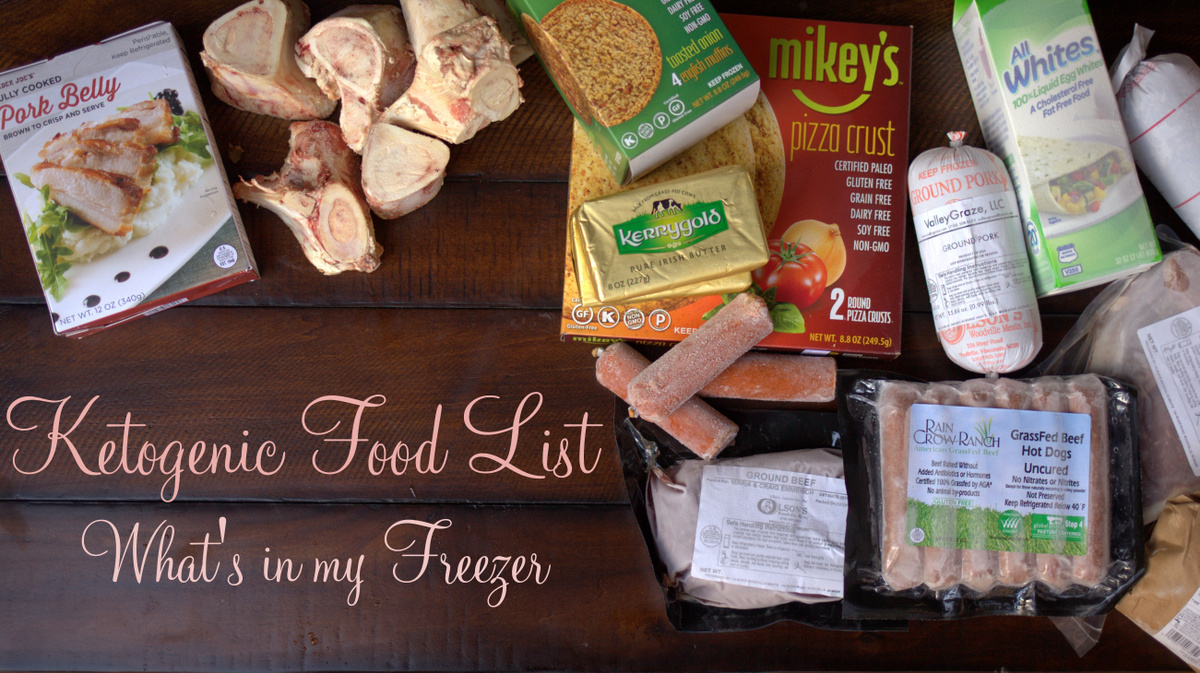Your cart is currently empty!
Getting Started Guide
Welcome to keto-adapted.com. If you are new to keto this page will give you everything you need to get started with a ketogenic lifestyle.
Here is what we will cover in this guide (click to go to that section):
-
Keto Macro Targets
-
Keto Pantry
-
Keto Whole Foods
-
What to Expect
-
Using This Website
-
Protein Sparing Modified Fasts
-
Get Started Meal Plans
Keto Macro Targets
A ketogenic lifestyle can have many benefits including short and long term health. But there are many things said out there about this lifestyle that can lead you down the wrong path. In this section I will discuss what a Well Formulated Ketogenic Lifestyle looks like and how you can eat the proper nutrient dense foods to realize your best health.
What are Ketogenic Macros?
There is a lot of discussion in different groups that call themselves keto about what macros result in a ketogenic state. Some say don’t count fat, eat all you want. Don’t count calories. Count net carbs. Add carbs before bed or carb ups. Through almost 20 years of working with clients we have found what works best.
It is actually a misnomer to call this a ketogenic diet. Or even a LCHF (low carb high fat) diet. When you are in a well formulated ketogenic state the majority of your fuel comes from free fatty acids (FFA) derived from your body fat or dietary fat. But your brain cannot fuel off of FFA’s. It can only fuel off of glucose (some areas can only use glucose) and ketones. Your brain needs about 50 grams of glucose and 80 grams of ketones to thrive.
So your body converts some of the FFA to ketones in the liver. This then fuels most of the brain. The remaining glucose requirements of the brain are then met through gluconeogenesis. This is the process where the body creates glucose from protein or triglycerides. Triglycerides are three free fatty acids connected together by one glycerol molecule. So when burning these for fuel they are broken into the three free fatty acid molecules to fuel the body and the glycerol molecule is turning into glucose for the brain. For about 10 grams of body-fat burned for fuel, you get about 1 gram of glucose. The liver can produce about 60-70 grams of glucose a day in this process (and from protein) providing the body (brain) all the glucose it needs. This means that there is NO dietary need for carbohydrates. Your body can produce what it needs.
When you are a sugar burner you run on glucose. During the day you can eat every couple hours as your body can store very little glucose in liver and muscles. Your body’s primary source of glucose is protein (muscles and bone). And this is one of the reasons why having constantly elevated glucose (and insulin) is so harmful. Not only the inflammation it causes but at night while you sleep, you run out of glucose so the body starts breaking down lean mass (muscle and protein) to get the glucose it needs to make it through the night. This causes deteriorating muscle mass, osteoporosis, etc. as we age. In fact this is the main cause of osteoporosis.
But once we switch our bodies fuel source to fat, this is no longer an issue. Even very lean athletes have 20-30,000 calories stored in their fat cells. So the body never needs to break down protein. In fact a ketogenic lifestyle has been shown to be very good at preserving muscle mass and reversing osteoporosis.
What is an Optimal Ketogenic State?
To be in ketosis means you are burning fat as your primary fuel source, not glucose. To achieve this state follow these guidelines.
Carbs:
The only thing you have to do to be in nutritional ketosis is to keep your carbs low enough. As stated above, there is no dietary need for carbohydrates when you are keto adapted. The only need is for feeding the bacteria in your gut microbiome. But even this is negligible. Maybe 10-20 grams of prebiotic fiber a day. But the need is even less (or zero) if you are replenishing a healthy gut with naturally fermented foods, organ meats, etc. or supplementing with a probiotic. So what I recommend is adding a little coconut vinegar which has the best prebiotic fiber called FOS. Add a bit each day (to water, etc.) and there will be little carbs added and you will keep your gut healthy. Also add naturally fermented foods and organ meats whenever possible.
To be in a ketogenic state you want to keep your carbs as low as possible. A good target is 20 grams of total carbs per day. We always count total carbs as we see many people kicked out of ketosis with too much fiber. The #1 goal for getting keto adapted is to get your total carbs to 20 grams or less per day.
Protein:
Protein intake is also an important part of a well formulate ketogenic lifestyle. It is also common in keto groups to fear protein. But why is that? It is a misunderstanding of how our body turns protein into glucose. CLICK HERE for more on why we don’t fear protein.
What is optimum? With our experience with clients we find that a good target for protein is 0.8-1.0 times your lean body mass (in pounds) for grams of protein a day. For example, if you weight 150 pounds and have 25% body fat that means your lean mass is (150*0.75) 112.5 pounds. So your protein target would then be (112.5*0.8) 90 grams of protein a day. That would be the minimum protein intake. If weight loss is the goal, or during PSMF days you might need a bit more protien. That is a goal that you should try to hit or exceed each day.
So in the example above your protein target would be 90 grams a day or more. It is more important to average out to your protein goal over the course of a week than to hit it every day.
Fat:
When you are keto adapted, your body can use dietary fat or body fat equally. So the more dietary fat you consume, the less body fat will be used for fuel. This is where the people that promote eating more and more fat fail. If you get your carbs low enough and hit your protein target, you will be in ketosis regardless of your fat intake. Fat is a limit when fat loss is a goal. Just use fat to keep you satiated and never add fat just to “Get your fat up” or “Reach a fat goal or percentage”.
Here is a good example of what weight loss should look like with this diet. Assuming your basal metabolic rate (BMR) is 1800 calories. You get 20 grams of carbs (80 calories), 75 grams of protien (300 calories) and 158 grams of fat (1422 calories). But notice, only 90 grams of that fat comes from dietary fat. The other 68 grams comes from burning stored body fat.
So don’t over do fat. No bullet proof coffee, fat bombs, etc. when trying to lose weight. You may need to add extra snacks in the first couple weeks of becoming keto adapted. But after that moderate the fat more to lose more. And if you want to break a stall or speed up fat loss, PSMF can help. CLICK HERE for a guide for PSMF days.
Calories:
Another point of conflict is with calories. Some say to not track and eat all you want. This might work for a little while (especially if coming from the standard American diet) but will quickly stall. As I stated in the fat section above, you want your body using body fat for fuel for weight loss, not dietary fat. We typically have our clients in the 900-1300 range of total calories when trying to lose body fat. Now if you are new to this lifestyle this may sound low. But when eating a well formulated ketogenic diet, the food is very nutrient dense. So you need far fewer calories to sustain you than with high carb diets. Look at this example of Luis from KetoGains:

“I have been practically eating one meal per day for a year, ranging between 1,300 to 1,900 kcals -with adequate nutrient partitioning and whole foods- No binges / cravings outside of the usual” – Luis Valladenor
Yes, this very muscular and very active trainer eats only 1300-1900 calories a day to maintain this physique. This is a great example of the nutrient density and macro needs of this lifestyle.
To calculate your own macros use our calculator HERE. If you are a Platinum member, you can get personal macro targets from us HERE.
Summary:
So to summarize, carbs are a threshold to stay under. Keep them below 20 grams a day. Protein is a target. Try to hit it most days. And fat is a dial you adjust up or down based on goals. The more you eat the less body fat is used for fuel. The less fat you eat, you will use more body fat (fat loss).
Get your Keto and Carnivore Macros (and PSMF macros) HERE!
Keto Pantry
CLICK HERE for a complete guide to Keto Baking Products.
If you are just starting out on your ketogenic lifestyle and are wondering how to get started, here are some of my tips!
1. Clean out your pantry. If you have sugary treats in your pantry, they are just going to call for you in the middle of the night until they are gone. Get rid of the junk.
2. Slowly start to get healthier and ketogenic options. It took me years to over-haul my pantry. Slowly over time, I found healthier salad dressings, healthier tomato sauces (in glass jars), healthier bone broth (such as Epic’s brand).
3. Double Check Ingredients for Sugar! Just because there are zero or low carbs on a condiment, check the ingredients. Trader Joe’s yellow mustard has sugar listed but it is still almost zero carbs. Just because something is at Trader Joe’s doesn’t mean it is healthy. I’m sure some of you are thinking, “duh!” BUT I had a client that was telling me her food diary from the past week and egg rolls were in her diary. I asked why in the world did you have that? She said, “Well, I got them from Trader Joe’s.”🙂
4. Check for MSG. MSG (an excitotoxin) causes damage to the neurons in your brain and has links to Parkinson’s disease, Alzheimer’s, Huntington’s disease and many others. Children are very susceptible to this type of effect on their sensitive and growing brains. Excitotoxins excite the neurons in the brain too much. They become exhausted and die. Neurotoxins are also a main cause of seizures. The damage may not be seen until many years later. When this happens, our neurotransmitters responsible for focus, mood, and memory have a hard time finding and recognizing their receptors due to the inflammation of the membranes on the brain cells caused by the consumption of MSG.
Brain levels of the neurotransmitter dopamine (important for mood and focus) are lowered by 95% when you ingest excitotoxins. BUT what is even more disturbing, is that when you switch to eating 100% free of processed food, our brain remains unable to produce normal amounts of dopamine in the hippocampus (the part of the brain most responsible for consolidating memory). This is one reason for the high rates of ADHD and depression. To read more on Brain Chemicals, check out my book: Secrets to Controlling Your Weight Cravings and Mood
5. Check for Food Dyes: It’s not just the hot pink cherries in the Captain Crunch that have these detrimental dyes; sugar free Jell-O, cheese, vegetable juice, and yogurt contain food coloring. Did you know cheese should be white? Synthetic dyes cause hyperactivity because it is an excitotoxin, where it over stimulates our dopamine production, but then we don’t produce enough; which causes a deficiency. ADD is a symptom of a dopamine deficiency. Click HERE to read more.
6. Check for maltodexterin! The danger is that maltodextrin is very high on the glycemic index: 105. This is 5 points higher than glucose which is 100. And, it is almost double that of table sugar which is around 59.
WHAT IS IN MY PANTRY
CLICK HERE for a complete list of products I recommend with coupons too!
For a Complete Guide to Baking Products go HERE.
For a Complete Guide To Sweeteners go HERE.
FATS
Saturated fats like MCT oil, coconut oil, butter, ghee, tallow, and lard are your best choice: They are stable, protect against oxidation, are anti-inflammatory, and have many other important health benefits. You want to avoid polyunsaturated fatty acids (PUFAs), which are unstable. When it comes to looking for oils and fats to include in your high-fat lifestyle, the higher the amount of saturated fat acids (SFA) the better. Grass-fed and organic sources are always best if you can get them.
MCT stands for “medium-chain triglycerides,” which are chains of fatty acids. MCTs are found naturally in coconut oil, palm oil, and dairy; MCT oil is extracted from coconut or palm oil and contains higher, concentrated levels of MCTs. Unlike coconut oil, it stays liquid even when refrigerated.
Here is a list of the best oils and fats to use with their SFA and PUFA content (compare the PUFA content of these good fats with the bad fats below):
1. MCT oil: 97 % SFA (less than 1% PUFA)*
Has a mild coconut flavor
Works great for sweet dishes, exotic Thai dishes and salad dressings
Can be heated
*MCT oil can be found at most health food stores, but if you have trouble finding it, you can use macadamia nut oil, avocado oil, or extra-virgin olive oil instead, keeping in mind that avocado oil is the most neutral-flavored of the three.
2. Coconut oil: 92% SFA (1.9% PUFA)
Has a strong coconut flavor
Works great for sweet dishes and exotic Thai dishes
Can be heated
Can also be used on the skin
3. Palm kernel oil: 82% SFA** (2% PUFA)
Neutral flavor
Works great for baking
Can be heated
**Be sure to purchase sustainable sourced and processed palm kernel oil. There are ecological concerns associated with some palm oils, such as endangering gorillas, so make sure to know the source.
4. Cocoa butter: 60% (3% PUFA)
Has a mild flavor
Works great for sweet and savory cooking
Can be heated
5. Butter: 50% SFA (3.4% PUFA )
Has a rich buttery flavor
Works great for all applications if you are not dairy sensitive
Can be heated, but not to a high temperature
6. Beef tallow: 49.8% SFA (3.1% PUFA)
Has a mild undertone of beef flavor
Works great for savory dishes
Can be heated
Has a mild buttery undertone flavor
Works great for all dishes: sweet and savory
Can be heated
Has a mild flavor
Works great for frying sweet or savory foods
Can be heated
9. Duck fat: 25% SFA (13% PUFA)
Has a rich duck flavor
Works great for frying savory foods
Can be heated
10. Macadamia oil: 15% SFA (10% PUFA)
Has a mild nutty flavor
Works great for salad dressings
Use in nonheat applications, such as salad dressings
11. Extra-virgin olive oil: 14% SFA (9.9% PUFA)***
Has a strong olive flavor
Works great for Italian salad dressings
Use in nonheat applications, such as salad dressings
***Extra-virgin olive oil is a good fat to include in a ketogenic lifestyle, BUT only when used in cold applications, such as salad dressings. Do not use olive oil for cooking; heat causes the oil to oxidize, which is harmful to your health.
12. Avocado oil: 11% SFA (10% PUFA)
Has a mild neutral flavor
Great for salad dressings
Can be heated
13. Hazelnut oil: 10% SFA (14% PUFA)
Has a mild hazelnut flavor
Works great for sweet dishes and exotic Thai dishes
Use in nonheat applications, such as salad dressings
14. Almond oil: 2% SFA (17% PUFA)
Has a mild neutral flavor
Works great for sweet dishes and exotic Thai dishes
Use in nonheat applications, such as salad dressings
Can also be used on the skin
15. Buffalo Tallow (57% SFA, 7% PUFA):
Very Flavorful
Great for frying
Adds a unique flavor
16. Leaf Lard (40% SFA, 10% PUFA):
OK to heat
Doesn’t add much flavor
Very versatile
17. Bacon Fat (40% SFA, 10% PUFA):
Add great flavor
OK to heat
18. Schmaltz (30% SFA, 21% PUFA):
OK to heat
A bit higher in PUFA than others
19. Suet (75% SFA, 3% PUFA):
Great for frying
Harder to work with than Tallow (which is rendered from suet)
Bad Fats to Avoid
There are two kinds of fats that should be avoided. The most inflammatory fats are trans-fatty acids (trans fats). Trans fats are one of the worst substances we can consume for our overall health. There are many studies that show the heart disease and cancer risks of trans fats. Here is a list of trans fats to avoid at all cost:
1. Margarine
2. Vegetable shortening
3. Hydrogenated oils or partially hydrogenated oils (look for these on ingredient labels)
Polyunsaturated fatty acids (PUFAs) should also be limited as they are prone to oxidation. There are many oils high in PUFAs. These should be eliminated (or kept to a minimum like peanut or sesame oil). Here is a short list of some of the most common:
Grapeseed oil: 70.6% PUFA
Sunflower oil: 68% PUFA
Flax oil: 66% PUFA
Safflower oil: 65% PUFA
Soybean Oil: 58% PUFA
Corn oil: 54.6% PUFA
Walnut oil: 53.9% PUFA
Cottonseed oil: 52.4% PUFA
Vegetable oil (soybean oil): 51.4% PUFA
Sesame oil: 42% PUFA
Peanut oil: 33.4% PUFA
Canola oil: 19% PUFA
KETOGENIC SNACKS
3. Canned Anchovies
8. Beef Sticks and Beef Jerky (homemade recipe, click HERE.)
9. Nuts (avoid cashews, chestnuts and pistachios). Pili nuts are best.
10. Olives (green and black)
CLICK HERE for all my Favorite snacks and coupons too!

Herbs and Spices
Anise, annatto, basil, bay leaf, black pepper, caraway, cardamom, cayenne pepper, celery seed, chervil, chili pepper, chives, cilantro, cinnamon, cloves, coriander, cumin, curry, dill, fenugreek, galangal, garlic, ginger, lemongrass, licorice, mace, marjoram, mint, mustard seeds, oregano, paprika, parsley, peppermint, rosemary, saffron, spearmint, star anise, tarragon, thyme, turmeric
Avoid: Spice blends with added sugars or preservatives. Some with extracts and flavorings like vanilla.
AND MY NEW KETO SPICE BLENDS!
HEALTHY TIP: Cinnamon (must be ceylon, not the typical cassia. Cassia has a compound that can be harmful over time)
Nuts and Seeds
Almonds, Brazil nuts, hazelnuts, macadamia nuts, pecans, pumpkin seeds, sesame seeds, sunflower seeds, walnuts, Pili nuts.
Almond Butter, macadamia nut butter, pecan butter, sunflower butter (check for no sugar, I make my own and have recipes HERE.)
Avoid: cashews, chestnuts and pistachios.
Baking Supplies
4. Cocoa butter
5. Baking soda
6. Baking powder
7. Xanthum and guar gum (thickeners)
9. Unsweetened baking chocolate
10. Extracts: Apple, strawberry, raspberry, caramel, maple, vanilla, almond, peach
11. SWERVE sweetener (general purpose sweetener).
CLICK HERE for all my favorite baking product with Coupons too!
Other Pantry Items
1. BONE BROTH: I am more like you than you realize… you can find me opening a jar of Epic organic beef broth instead of making my own broth quite often. BUT when I am not overwhelmed with work, I slow down and prepare a lot of things I know I should be doing such as making my own bone broth.
2. Gelatin: I don’t use regular store brand gelatin. I use Great Lakes Gelatin. It is made from pastured cows in Argentina that have not been treated with antibiotics or hormones. I bought a HUGE amount (gelatin doesn’t spoil!). Remember, Red can = gels up like jello, green can = doesn’t gel up.
3. Coconut Vinegar and Apple Cider Vinegar. Watch this video on why coconut vinegar.
4. Salad Dressings: Check for healthy oils and no sugar.
5. Mustards: Check for no sugar. Organic is preferred.
6. Mayo: check for junky oils and added sugar
7. Kelp Noodles
8. Tomato Sauce in glass Jars: the acid in tomatoes leach metal if stored in aluminum cans. THIS brand works great for making ketogenic ketchup!
9. Pork Dust
10. Miracle Noodles and Miracle Rice
11. Nori Sheets: for making my Egg Rolls!
12. Marinara sauce: made with quality olive oil and no sugar added!
CLICK HERE for more pantry items items with coupons too!
KETOGENIC DRINK IDEAS
2. Everly natural sugar free drink mix!
3. LaCroix mineral water. I love the strawberry kiwi!
4. Steaz Tea
5. Bone Broth: makes a tasty warm beverage!
6. Zevia soda.
7. Bone broth! Warm up for a tasty drink.
So these are just some of the ingredients that can get you started on “healthifying” your pantry! Don’t wait another day! You DESERVE this! It took me years… no, more than a decade, to “healthify” my pantry. I wish I would have ripped the band-aid off and did it all right away. It would have helped me so much. Don’t waste a decade like I did!
CLICK HERE for drink option with coupons too!
Keto Whole Foods
If you are just starting out on a ketogenic diet, or if you have been keto for a while but are looking for some new ideas on how to stock your fridge or freezer, here are some of my favorites!
Vegetables
Look for low starch veggies. Also watch for “sweet” varieties of things like onions. A yellow onion (for 1/2 cup chopped) can have 3.5g carbs where a sweet red onion can have 9g carbs.
Veggies to enjoy regularly:
Arugula, asparagus, bok choy, broccoli, cabbage, cauliflower, celery, collard greens, cucumber, endive, garlic, kale, kelp, lettuce (red leaf, Boston leaf lettuce, romaine, radicchio), mushrooms, onions (green, yellow, white, red), peppers (bell, jalapenos, chili peppers), seaweed, Swiss chard, watercress, zucchini. Even some of these can be overdone if weight loss is your goal. Always include the carbs in your totals.
Good veggies in moderation:
Daikon, brussels sprouts, jicama.

Fruit
Olives, tomato, coconut, capers, avocado, cucumber, eggplant, lemons, limes
Occasional treat when in season (avoid if trying to lose weight): wild berries like raspberries, strawberries, blackberries.
AVOID: All other fruits. Just natures candy loaded with sugar and not needed.
BREADS
Keto Bread and Keto Buns: I always have on hand for a hamburger or sandwich!
EASY MEALS:
Trader Joe’s Pork Belly: all you have to do is fry it up until crisp!
A dozen hard boiled eggs: I always make deviled eggs!
Liver: organ meat is an under-appreciated ketogenic food with more nutrients than most fruits and veggies! My mom saw the liver in my freezer and begged for a package so she could have liver and onions! Animal proteins are the most nutrient dense foods, not fruits and veggies.
US Wellness Meats makes has great sugar free cured meats and organ meats.
EASY TREATS:
Ice Cream: You will ALWAYS find Keto Vanilla Bean Ice cream in my freezer!
Push-Pops: My kids enjoy one of these on our long evening bike rides!
SAUCES:
Red Boat Fish Sauce: it adds “umami” to marinades and salad dressings
Coconut Aminos: a great gluten free and soy free soy sauce
CLICK HERE to jump up to more options like mayo, dressing, etc.
Proteins
CLICK HERE for all our favorite proteins and coupons too!
Wild Meats:
Bear, boar, buffalo, elk, rabbit, venison
US Wellness has a great selection.
Farmed Meats:
Beef, goat, lamb, pork
Butcherbox is our favorite for getting meat delivered! CLICK HERE to get it.
Fish:
Ahi, Catfish, Halibut, herring, mackerel, mahi mahi, salmon, sardines, snapper, swordfish, trout, tuna, walleye, white fish (cod, bluegill, crappies)
CLICK HERE to get Sizzlefish delivered!
Seafood:
Clams, crab, lobster, mussels, oysters, prawns, scallops, shrimp, snails
CLICK HERE to get Sizzlefish delivered!
Poultry:
Chicken, chicken livers, duck, game hen, goose, ostrich, partridge, pheasant, quail, squab, turkey
Butcherbox is our favorite for getting chicken delivered! CLICK HERE to get it.
Eggs:
Chicken eggs, duck eggs, goose eggs, ostrich eggs, quail eggs
This covers a good chunk of the whole foods that are great for a ketogenic lifestyle. If there are other specific items you would like our opinion on, just use the Question and Answer module.
What to Expect
In the first week or two as your body switches its fuel source to fat or you become keto adapted, you may see a dip in energy. So don’t plan any big workouts during this time. Also, your body releases much of the water (and electrolytes like salt, potassium and magnesium) that it holds onto with higher carb diets. So you may see a quick loss of water weight (in first few days) but it also means you need to add extra water and electrolyte. So add extra salt to your food, potassium, magnesium and lots of water. Shoot for a gallon of water a day. The minimum is half your total body weight in ounces of water a day. This will help with energy levels. Also, if you experience headaches, cramps, restless leg, etc. during this time you need more water and electrolytes.
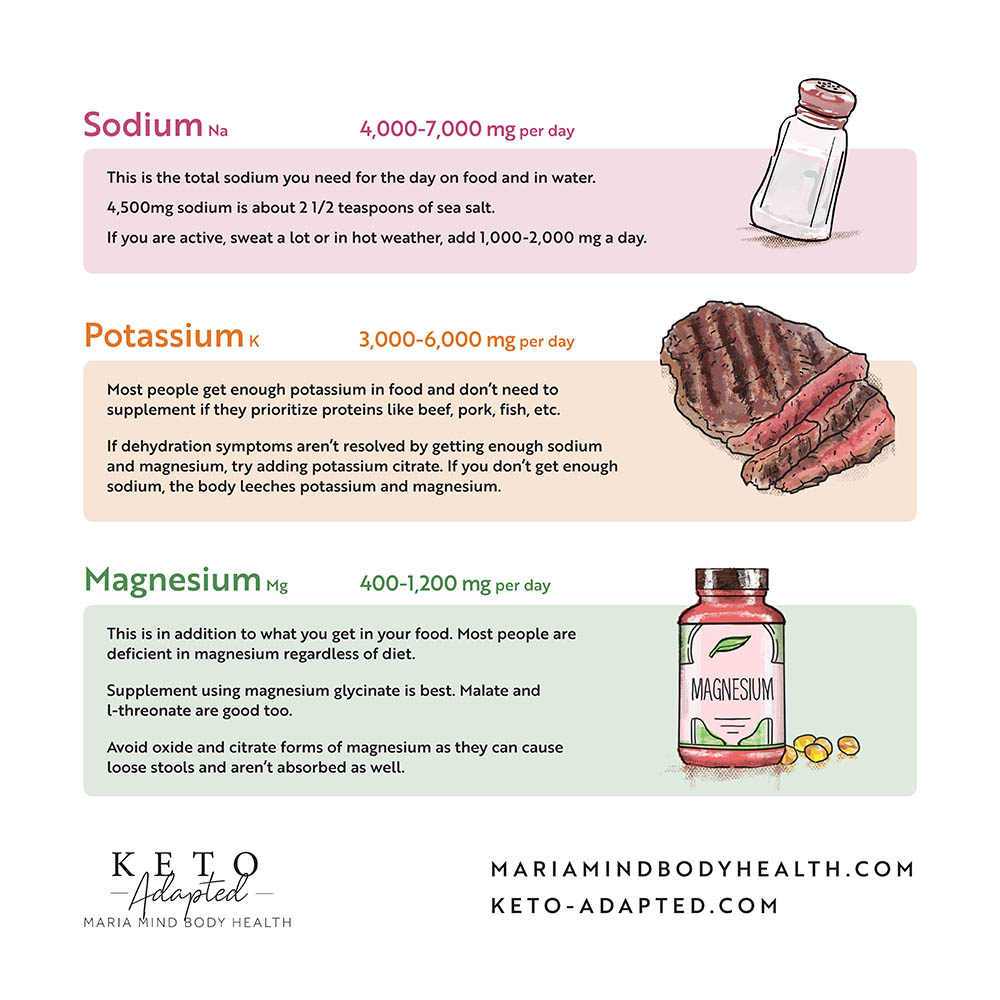
After a couple weeks you should start to see your energy increase. This is your body beginning to use fat for fuel. Everyone is different in the time it takes to get keto adapted. Some will see the effects after just a few days. Others with a lot of metabolic damage may take 6 weeks or more. Just focus on getting the carbs low enough and hit your protein target and you will get there. During the adaption time if you need more dietary fat to keep cravings and hunger away, add fat bombs, keto fudge or other high fat very low carb snacks. This will help fuel your body until your body gets better at making its own fat fuel (from stored body fat).
After 3 to 4 weeks most people will start seeing their energy soar, cravings go away, hunger stops. They stop thinking about food all day like in the past. This is also where you can think about adding intermittent fasting if you haven’t already added it. This is where you eat 2 meals a day instead of 3 and eat all your food in a 6 hour window of time (6 is ideal, 8 is OK). This chart shows an example.
There are many benefits to intermittent fasting as shown. It is a great and natural addition to a ketogenic lifestyle. This window can be moved to whatever works best (start eating at noon and stop at 6PM, etc). Just make sure not to eat any calories at least 3 hours before bed.
But to be clear, getting your macros right is more important than any intermittent fasting. So if adding intermittent fasting means you don’t hit your protein goal or get your macros right, then I would prefer you got macros right than do any intermittent fasting.
Using This Website
There are many tools on this website to help you stay on track. THIS HOME page lists all of them. Make sure to watch the videos HERE showing you how to use this site. If you have any questions feel free to contact us (HERE). We are here to help!
